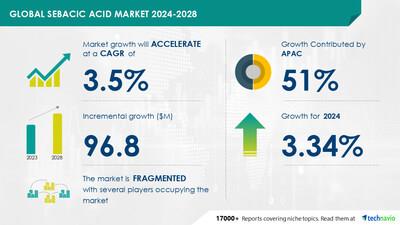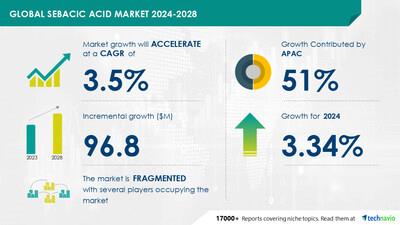
Sebacic Acid Market To Grow By USD 96.8 Million (2024-2028) Driven By Automotive Demand, AI's Impact On Trends - Technavio Report
| Forecast period |
2024-2028 |
| Base Year |
2023 |
| Historic Data |
2018 - 2022 |
| Segment Covered |
Application (Polymer manufacturing, Coolants, Industrial use, Ester manufacturing, and Others), Source (Castor oil and Adipic acid), and Geography (APAC, North America, Europe, South America, and Middle East and Africa) |
| Region Covered |
APAC, North America, Europe, South America, and Middle East and Africa |
| Key companies profiled |
Arkema SA, Central Drug House Pvt. Ltd., Chemtech B.V., Corvay GmbH, Hengshui Jinghua Chemical Co. Ltd., HOKOKU Corp., Inolex Inc., Jayant Agro Organics Ltd., LABDHI CHEMICALS, Merck KGaA, Naugra Export, Santa Cruz Biotechnology Inc., Sebacic India Ltd., Shivam Castor Products Pvt. Ltd., Silver Fern Chemical Inc., Thermo Fisher Scientific Inc., Tianxing Biotechnology Co. Ltd., Tokyo Chemical Industry Co. Ltd., Wilmar International Ltd., and Wincom Inc. |
Key Market Trends Fueling Growth
The global sales of electric vehicles (EVs) have been on the rise due to increasing government initiatives, subsidies, and consumer awareness. EVs use cost-effective and high-performing zinc-bromine batteries, which are preferred over lead-acid batteries due to their eco-friendly attributes. As sebacic acid is commonly used as a coolant in internal combustion engines in conventional vehicles, the growing popularity of EVs has led to a decrease in the demand for this acid. Consequently, the expanding EV market is expected to negatively impact the sebacic acid market during the forecast period.
The Sebacic acid industry is experiencing significant growth, particularly in markets served by coating applications, personal care, healthcare, construction, lubricants & greases, metalworking fluids, adhesives, decorative materials, bio-based polymers, and household care. The trend towards environmental awareness and the production of bio-based products is driving demand for Sebacic acid, a dibasic acid derived from castor oil. Recent innovations in the Sebacic acid industry include the development of bio-based polymers, LAMEA markets, and EDNOL DOZ. Sebacic acid is also used as a raw material in the production of bio-based plasticizers like Azelaic acid-based plasticizer. Manufacturing cost and production growth rate are key factors influencing the industry. The Sebacic acid industry sources raw materials from castor oil and competes with Adipic acid in various applications. Carbon monoxide emissions are a concern for Sebacic acid manufacturers, and strategies to address this include solidness and hydrophobicity in production processes. Other challenges include high initial investment, intermittency and reliability, infrastructure limitations, supply chain disruptions, public perception, and adaptability to changing market dynamics. Emerging estimations & dynamics indicate continued growth in the Sebacic acid industry, particularly in personal care & cosmetics, lubricants, textiles, paints & coatings, and plasticizers. Companies like Emery Oleochemicals are leading the way with innovative solutions and product positioning.
Insights on how AI is driving innovation, efficiency, and market growth- Request Sample!
Market
Challenges
-
The global sebacic acid market faces challenges due to the volatility in the prices of castor seeds, which are the primary raw material. India, the largest producer and exporter of castor oil, dominates the market. However, the production of castor seeds in India is heavily influenced by climatic conditions, particularly in Gujarat, where most of the seeds are cultivated. Extreme weather conditions and an unorganized farming sector have led to a decline in production, which can impact the supply chain. The optimum temperature for castor oil plant growth is between 68 degree F and 77 degree F, but temperatures exceeding 212.7 degree F can negatively affect seed setting. Low temperatures can also be detrimental. Price fluctuations and supply-demand imbalances, caused by factors such as availability of inexpensive substitutes and long storage periods, can impact the global castor oil and sebacic acid markets. In 2021, India's castor oil supply was insufficient due to high demand from major consumers like China, the US, and others. As castor oil is a major source of sebacic acid, price volatility in castor oil can negatively impact the growth of the global sebacic acid market.
The Sebacic Acid market faces several challenges in various industries such as metalworking fluids, coatings, adhesives, decorative materials, bio-based polymers, and LAMEA. One significant challenge is the increasing demand for eco-friendly alternatives to traditional plasticizers like EDNOL DOZ. Azelaic acid-based plasticizers offer a solution, but their product positioning requires adaptability and environmental awareness. Emerging markets served by Sebacic Acid include personal care & cosmetics, lubricants, textiles, household care, and paints & coatings. Recent innovations include bio-polyamides and lower dissolving temperatures for polyesters. However, high initial investment, intermittency and reliability, infrastructure limitations, and supply chain disruptions pose challenges. Public perception, solidness, hydrophobicity, and chemical resistance are critical factors in product lines. Dermatologists' recommendations and labor force availability are also essential considerations. The economic crisis adds to the complexities of the market landscape. Strategies for success include focusing on product quality, cost competitiveness, and sustainability.
Insights into how AI is reshaping industries and driving growth-
Download a Sample Report
Segment Overview
This sebacic acid market report extensively covers market segmentation by
Application-
1.1 Polymer manufacturing
1.2 Coolants
1.3 Industrial use
1.4 Ester manufacturing
1.5 Others
-
2.1 Castor oil
2.2 Adipic acid
-
3.1 APAC
3.2 North America
3.3 Europe
3.4 South America
3.5 Middle East and Africa
1.1 Polymer manufacturing-
Nylon 6,10 is a commercially significant polymer produced by reacting hexamethylenediamine with sebacic acid, which is then polymerized at approximately 240 degrees Celsius. Nylon 6,10 offers superior properties, including high dimensional stability and electrical conductivity, compared to nylon 6 and 6.6. This polymer is widely used in engineering plastics applications, such as automotive parts, instrument panels, control consoles, transducers, engine structures, wheel gears, LED holders, radiators, and LED connectors. Additionally, nylon 6,10 is extensively utilized in textile applications due to its lower moisture absorption and enhanced strength. Its resistance to environmental stress cracking caused by salts like zinc chloride further increases its demand. The rising requirement for nylon 6,10 in various applications is anticipated to boost the demand for sebacic acid during the forecast period.
Download complimentary Sample Report to gain insights into AI's impact on market dynamics, emerging trends, and future opportunities- including forecast (2024-2028) and historic data (2018 - 2022)
Research Analysis
The Sebacic acid market is experiencing significant growth due to its wide application in various industries. This organic compound, derived from the condensation of succinic acid and 1,6-hexanediol, is gaining popularity in the production of bio-based products due to its low carbon monoxide emissions. The Sebacic acid industry serves markets such as personal care, healthcare, construction, coatings, adhesives, and decorative materials. The production growth rate is driven by recent innovations in the field, including the development of new applications and the increasing demand for sustainable and eco-friendly products. Gross profit margins in the Sebacic acid market are influenced by factors such as supply chain disruptions and public perception. The industry is currently facing challenges due to the volatility of raw material prices and logistical issues. However, the growing awareness of the environmental benefits of Sebacic acid is expected to drive demand and offset these challenges. Despite these challenges, the future looks bright for the Sebacic acid market. With continued innovation and investment in research and development, this versatile compound is poised to make a significant impact in various industries and applications.
Market Research Overview
Sebacic acid is a versatile dibasic carboxylic acid with the molecular formula C16H28O4. It is derived from the hydrolysis of castor oil and is known for its unique properties, including solidness, hydrophobicity, and lower dissolving temperatures. Sebacic acid is gaining popularity in various industries due to its eco-friendly production and wide range of applications. The Sebacic acid industry is growing at a significant rate, driven by the increasing demand for bio-based products in markets served by LAMEA (Latina America, Middle East, Africa, Europe, and Asia-Pacific). The industry caters to various sectors, including personal care, healthcare, construction, lubricants & greases, metalworking fluids, coatings, adhesives, decorative materials, bio-based polymers, and plasticizers. Recent innovations in the Sebacic acid industry include the production of bio-based polymers, such as Bio-polyamides, and the development of Azelaic acid-based plasticizers. The industry's growth is influenced by factors such as product positioning, adaptability, environmental awareness, and strategies to overcome challenges like high initial investment, intermittency and reliability, infrastructure limitations, supply chain disruptions, public perception, and chemical resistance. Sebacic acid is used in various applications, including the production of polyesters, dermatologists' formulations, and as a building block for various chemical products. Its use in personal care and cosmetics, household care, and paints & coatings is increasing due to its solidness, hydrophobicity, and lower dissolving temperatures. The healthcare sector also utilizes Sebacic acid in the production of various pharmaceuticals and medical devices. The Sebacic acid industry's manufacturing cost is influenced by the source of raw materials, mainly castor oil, and the production process's efficiency. The industry's growth rate is expected to be significant due to the increasing demand for bio-based products and the emergence of new applications. Carbon monoxide emissions are a concern in the production of Sebacic acid, and efforts are being made to reduce these emissions through the implementation of cleaner production processes. The industry is also facing challenges such as labor force availability, economic crisis, and supply chain disruptions. Despite these challenges, the Sebacic acid industry is poised for growth due to its versatility, eco-friendliness, and wide range of applications.
Table of Contents:
1 Executive Summary
2 Market Landscape
3 Market Sizing
4 Historic Market Size
5 Five Forces Analysis
6 Market Segmentation
-
Application
-
Polymer Manufacturing
Coolants
Industrial Use
Ester Manufacturing
Others
-
Castor Oil
Adipic Acid
-
APAC
North America
Europe
South America
Middle East And Africa
7 Customer Landscape
8 Geographic Landscape
9 Drivers, Challenges, and Trends
10 Company Landscape
11 Company Analysis
12 Appendix
About Technavio
Technavio is a leading global technology research and advisory company. Their research and analysis focuses on emerging market trends and provides actionable insights to help businesses identify market opportunities and develop effective strategies to optimize their market positions.
With over 500 specialized analysts, Technavio's report library consists of more than 17,000 reports and counting, covering 800 technologies, spanning across 50 countries. Their client base consists of enterprises of all sizes, including more than 100 Fortune 500 companies. This growing client base relies on Technavio's comprehensive coverage, extensive research, and actionable market insights to identify opportunities in existing and potential markets and assess their competitive positions within changing market scenarios.
Contacts
Technavio Research
Jesse Maida
Media & Marketing Executive
US: +1 844 364 1100
UK: +44 203 893 3200
Email:
[email protected]
Website:
SOURCE Technavio

Legal Disclaimer:
MENAFN provides the
information “as is” without warranty of any kind. We do not accept
any responsibility or liability for the accuracy, content, images,
videos, licenses, completeness, legality, or reliability of the information
contained in this article. If you have any complaints or copyright
issues related to this article, kindly contact the provider above.



















Comments
No comment